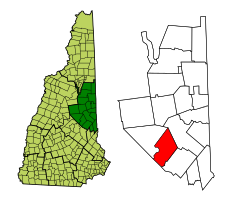Tuftonboro, New Hampshire
| Tuftonboro, New Hampshire | |
|---|---|
| Town | |

Melvin Village from Lake Winnipesaukee c. 1906
|
|
| Motto: The Diamond in the Heart of New Hampshire | |
 Location in Carroll County, New Hampshire |
|
| Coordinates: 43°41′46″N 71°13′21″W / 43.69611°N 71.22250°WCoordinates: 43°41′46″N 71°13′21″W / 43.69611°N 71.22250°W | |
| Country | United States |
| State | New Hampshire |
| County | Carroll |
| Incorporated | 1795 |
| Government | |
| • Board of Selectmen | Carolyn Sundquist, Chair Lloyd P. Wood William J. Marcussen |
| Area | |
| • Total | 50.0 sq mi (129.5 km2) |
| • Land | 41.0 sq mi (106.1 km2) |
| • Water | 9.0 sq mi (23.4 km2) 18.07% |
| Elevation | 988 ft (301 m) |
| Population (2010) | |
| • Total | 2,387 |
| • Density | 48/sq mi (18/km2) |
| Time zone | Eastern (UTC-5) |
| • Summer (DST) | Eastern (UTC-4) |
| ZIP codes | 03816, 03850, 03853, 03894 |
| Area code(s) | 603 |
| FIPS code | 33-77620 |
| GNIS feature ID | 0873741 |
| Website | www.tuftonboro.org |
Tuftonboro is a town in Carroll County, New Hampshire, United States. The population was 2,387 at the 2010 census. Bounded on the southwest by Lake Winnipesaukee, Tuftonboro includes the villages of Tuftonboro Corner, Center Tuftonboro, Melvin Corner, Melvin Village and Mirror Lake.
Tuftonboro was the only incorporated place in New Hampshire owned by just one man, John Tufton Mason, for whom the town was named. Following the 1741 separation of New Hampshire from Massachusetts, Mason was heir to the Masonian Claim, the undivided lands of northern New Hampshire. He sold them in 1746 to a group of Portsmouth merchants, thereafter known as the Masonian Proprietors. They disposed of the land via grants to prospective settlers prior to the Revolution.
The town was granted as Tuftonborough in 1750 by Colonial Governor Benning Wentworth, and first settled about 1780. It was incorporated by the legislature on December 17, 1795. By 1859, when the population was 1,305, the principal occupation was raising cattle and sheep across the hilly terrain. Other industries included 2 sawmills, one sash, blind and door factory, one carriage factory, and 2 gristmills.
...
Wikipedia
